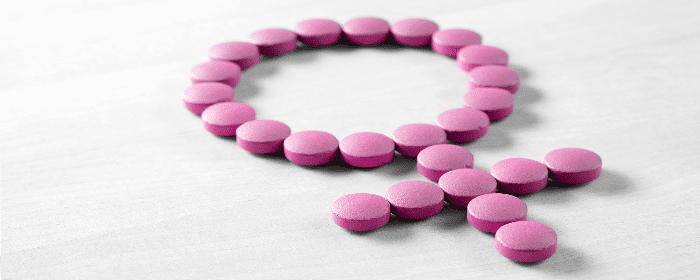
by admin | Oct 21, 2019 | Health Awareness, Parkinson's Disease
Parkinson’s disease (PD) is a progressive nervous system condition which is diagnosed in more than 50,000 Americans each year. The disease affects movement and occurs when nerve cells in the brain don’t produce enough of the brain chemical dopamine.
Patients with Parkinson’s disease experience the death of neurons involved with the movement, which may lead to symptoms such as tremors, mobility challenges, slow movement, muscle rigidity, and speech changes. Cell death may be partially caused by a mutation for the protein α-synuclein (αS). While the mutated protein tends to cluster in neurons, ultimately causing their death, the normal protein resists clumping.
Researchers are now investigating whether estrogen could help to protect these movement neurons against clumping in people with PD.
Parkinson’s disease is most commonly seen in men and postmenopausal women, both of whom have low estrogen levels. While researchers still aren’t sure precisely how estrogen may act as a protective agent to safeguard movement neurons, studies have shown that brain-selective estrogen improved PD symptoms in mice. In the studies, the mice treated with estrogen therapy showed a higher rate of surviving neurons, as well as benefits in motor performance. It’s therefore suspected that estrogen treatment could be an effective therapy for delaying and reducing symptoms.
The exact causes of Parkinson’s disease are still being researched. While the condition can be genetic, most cases do not appear to run in families. As with many conditions, experts believe that environmental factors, including exposure to chemicals, could contribute to the disease. While there is still further research to be done both on the disease in general and the potential benefits of estrogen therapy, these most recent findings suggest that estrogen could hold promise as an emerging treatment for men and menopausal women with Parkinson’s disease.

by admin | Oct 15, 2019 | Health Awareness, Parkinson's Disease
For some time now, gut health has been suspected to play a key role in chronic conditions. We now know that there is significant interaction between the body’s immune system and bacteria in the intestinal tract, and researchers have become increasingly interested in how the immune system ties into conditions such as Parkinson’s disease (PD). But how do these factors all connect?
The Potential Role of Gut Infections in Parkinson’s Disease
Emerging research suggests Parkinson’s disease could have an autoimmune component. Autoimmune conditions occur when the body’s immune system confuses healthy cells for pathogens and sets out to destroy them. A small percentage of PD cases are caused by mutations in genes that code for the proteins PINK1 and Parkin, which help clear out damaged mitochondria. Individuals with these mutations are more likely to develop PD before the age of 50.
Yet, when scientists removed PINK1 and Parkin from mice in a recent study, thereby giving them the same mutations linked to Parkinson’s disease in humans, they did not develop the disease. The research team theorized that factors other than these genetic mutations alone would likely be required for PD to develop. In particular, they believed exposure to specific germs could trigger Parkinson’s disease in individuals with this mutation.
To test this theory, the mice were exposed to E. coli. As the researchers suspected, they experienced PD-like symptoms later in life, along with a loss of dopaminergic neurons in the brain. This suggests that in individuals with certain genetic mutations, gut infections can trigger an immune system response which targets healthy cells.
What the Findings Mean
This research has also led scientists to the conclusion that in people without functioning PINK1 and Parkin, intestinal infections can trigger PD, thereby demonstrating a clear gut-brain connection in the disease. While this doesn’t suggest that all PD cases are autoimmune, it does pose the theory that there could be an immune system element in some cases. Although the mystery surrounding Parkinson’s disease still remains, this discovery points to an interplay between the gut, genetics, and brain, which may ultimately pave the way for further developments in the realm of treatment.

by admin | May 1, 2019 | CBD, Parkinson's Disease
Recently a video went viral in which a man with Parkinson’s disease (PD) tries cannabis for the first time, placing a drop of cannabinoid oil (CBD oil) under his tongue. Within minutes, his symptoms improve significantly: the dyskinesia (involuntary muscle movements) disappears almost entirely, and his voice returns. The significant reaction to the drug begs the question: can cannabis be used to help manage PD?
Clinical Studies on Medical Marijuana for PD
Unfortunately, as the Parkinson’s Foundation points out, the clinical trials on using marijuana for PD have been incredibly varied. Some studies use as few as five participants, and as a result, fail to meet the minimum research standards needed to garner support among the medical community. That hasn’t stopped patients from seeking the treatment themselves, however: 95% of neurologists say their patients have asked for a medical marijuana prescription.
Moreover, groups like The Michael J. Fox Foundation, among others, have called for the reclassification of marijuana, which could make it easier to conduct research. Currently, marijuana is classified as a Schedule I drug by the federal government. Drugs within this category are deemed to have a high potential for abuse and no known acceptable medical applications. To complicate matters further, there is currently a lack of standardized or known doses for CBD, as well as variable concentrations of the active ingredient. Nonetheless, in low doses, CBD appears to be well tolerated, though it poses side effects such as cognitive changes, nausea, and dizziness.
How Does CBD Work?
We know that the chemicals in marijuana react with the brain’s cannabinoid receptors. What researchers are still working to figure out is precisely how CBD effects these receptors. Trials show mixed results: while some patients have experienced improved motor and non-motor symptoms, others did not experience improvement. Limited studies show decreases in psychosis and tremors, as well as improvements in quality of life.
Could Cannabis Be Right for You?
While incorporating any form of cannabis will likely not replace PD medications, it’s possible that patients may experience a reduction in symptoms with CBD use. If you’re considering this treatment, talk to your doctor, who can recommend a treatment regimen based on your needs.
Visit our website for available hemp extract products. Click here

by admin | Apr 23, 2019 | Health Awareness
At one point or another, you’ve probably come across something about the “keto diet,” whether it’s a friend who’s lost weight on it or an article on the newsstand. Indeed, it appears that following ketogenic (keto for short) eating principles is the latest dieting fad which has taken the masses by storm. While it does have the potential to spur significant weight loss, however, it also carries certain risks. Here’s what you need to know before going keto.
What Is the Keto Diet?
At the most basic level, keto is a low-carb, high-fat approach to eating. It bears similarities to the Atkins diet and similar low-carb eating plans. Essentially, it requires dieters to drastically limit their intake of carbohydrates (which are found in everything from breads, pasta, and cereal products to fruit) and to replace them with fat. For those who follow the plan strictly, it means breaking down nutrition as follows:
- 75% fat
- 20% protein
- 5% carbohydrates
The average American diet consists of 50-65% of carbohydrates, so the keto diet requires a major dietary overhaul for most people. By making these changes, you’ll send your body into a different metabolic state known as ketosis.
What is Ketosis?
Ketosis is the process by which the body uses stored fat for energy. This occurs when there isn’t enough glucose to provide energy. As stored fat is burned, a buildup of acids known as ketones develop, which can supply the brain with energy. To determine whether they’ve reached ketosis, many individuals who pursue the diet use urine strips or blood pricks. Eventually, however, most people become able to recognize the feeling of being in ketosis.
Keto Meal Planning
Most variations of the keto diet require a strict, principled approach to eating in which high-fat foods like oils, butter, avocado, cheese, coconut, and nuts are used to satisfy the appetite. Non-starchy vegetables such as broccoli, asparagus, zucchini, peppers, and cucumbers, as well as leafy greens, are also permitted. Meats, eggs, and fish can be consumed regularly as well.
The list of restricted foods spans far and wide, however. Most fruits are not permitted, nor are grains of any type, heavily processed foods, alcohol, and milk, among many other foods and drinks.
Keto Diet Benefits
Weight loss is one of the main drivers that attracts people to the keto diet. More than 20 studies have supported low-carb eating approaches, indicating that reducing carbohydrate intake can help people lose weight. This is likely due to the fact that cutting carbs also requires you to nix simple, refined carbohydrates, which are typically caloric yet have little nutritional value.
It’s also suspected that the keto diet may help to control or prevent certain diseases, including epilepsy, metabolic syndrome, type 2 diabetes, obesity, dementia, Parkinson’s disease, polycystic ovarian syndrome, and certain types of cancer.
Despite its potential benefits, however, further research is still limited, especially in terms of long-term results. There are also certain risks all participants should consider before embarking on this diet.
Keto Diet Risks
One of the most notorious impacts of the diet is the “keto flu.” As the body adapts to this new eating approach, it experiences flu-like symptoms, including headaches and fatigue. Water is also lost early on, which can lead to dehydration – a potentially serious condition. It’s therefore critical to drink plenty of water, especially at first.
The diet is also difficult to stick with. Thus, while you may see results at first, it’s important to ask whether reducing carb intake so drastically is a practical long-term eating style you can maintain.
Additionally, a high-fat diet could lead you to take in too many saturated or trans fats, found in foods like red meat, cheese, butter, and poultry skin. These can cause “bad” cholesterol to spike and put you at risk for developing heart disease. Moreover, eliminating entire food groups can lead to unfavorable byproducts like kidney stones and constipation.
Ultimately, while the keto diet may be right for certain populations, it’s a good idea to have a talk with your doctor before you make the switch. By staying hydrated, limiting saturated and trans fats, and eating a healthy variety of keto-friendly foods, you may be able to find success with this approach.

by admin | Mar 23, 2019 | Hyperbaric Oxygen Therapy, Parkinson's Disease, Stem Cell Therapy, Studies
Parkinson’s disease is widely known as a neurological condition that causes motor symptoms. Typically, patients with Parkinson’s disease have pill-rolling tremor, cogwheel rigidity, and a shuffling gait. However, about half of all patients with Parkinson’s disease also have psychiatric symptoms such as anxiety and depression. It can be challenging for patients and caregivers to deal with Parkinson’s disease, but if anxiety and depression are also present, it can make matters worse. When psychiatric symptoms occur, they can make Parkinson’s disease more difficult to treat, increase the burden on caregivers, and greatly reduce quality-of-life for patients.
One of the things that make psychiatric symptoms so difficult to treat in patients with Parkinson’s disease is that doctors have limited treatment options. The antidepressants that they would normally use to treat depression and anxiety can make motor symptoms of Parkinson’s disease worse. People with Parkinson’s disease often struggle with sleep disturbances, and typical antidepressants can make sleep problems worse, too. Not surprisingly, many patients with Parkinson’s disease suffer from depression and anxiety and never find adequate treatment.
Physicians recently reported their experience with a patient with Parkinson’s disease who they treated with hyperbaric oxygen. The man had struggled with Parkinson’s disease for 1.5 years and had slipped into a severe depression. He had lost interest in pleasurable activities, was only sleeping about 2 to 3 hours each night, unintentionally lost over 40 pounds, and was having thoughts of suicide. He also had significant anxiety issues that made his life very difficult. Regular drug and psychotherapy treatments for anxiety and depression did not work for this man, so physicians were left with few options.
The man with Parkinson’s disease, severe depression, and anxiety underwent 30 days of hyperbaric oxygen treatments. He inhaled pure oxygen in a hyperbaric chamber for 40 minutes per session at 2 atm of pressure. In as little as four days of hyperbaric oxygen treatment, the man was sleeping better and longer than he did before treatment. His mood has also improved.
After 30 days of hyperbaric oxygen treatments, the man was able to sleep for 8 to 10 hours a night. Not only did his psychiatric symptoms improve, but his Parkinson’s disease symptoms also improved. While he still had Parkinson’s disease symptoms after hyperbaric oxygen treatment, the symptoms had improved substantially.
When physicians followed up one month after treatment had ended, the patient was still sleeping through the night, his mood was good, and he did not need assistance with his activities of daily living.
It is important to remember that this is a case study, the results of a single patient. Nevertheless, the improvements in both Parkinson’s disease and severe symptoms of anxiety and depression are incredibly impressive. For this man, at least, hyperbaric oxygen therapy had a substantial positive effect in his life where other treatments had failed.
Patients can also combine Hyperbaric Oxygen Therapy with Regenerative Medicine. Regenerative Medicine is an alternative option to help manage the symptoms of Parkinson’s Disease. The stem cells have the potential to replicate and repair numerous cells of the body, including those damaged by Parkinson’s. These advancements in the treatment of Parkinson’s Disease work to fully regenerate missing or damaged tissue that the body would not ordinarily regrow.
Call your dedicated Care Coordinator at 800-531-0831 for more information.
Reference: Xu, Jin-Jin et al. (2018). Hyperbaric oxygen treatment for Parkinson’s disease with severe depression and anxiety. Medicine. 2018 Mar; 97(9): e0029.






 St. Petersburg, Florida
St. Petersburg, Florida
